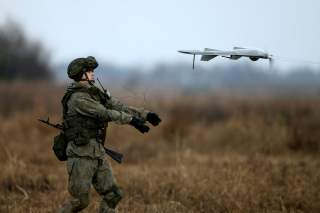Russia's Military Is Catching Up To America In This One Key Area
Think UAVs
While Russia has lagged behind the West is drone technology, Moscow is rapidly catching up leveraging its combat experience in Syria. Thus far, Russian unmanned aerial vehicles have amassed more than 14,000 sorties over that war-torn nation.
“The grouping of unmanned aerial vehicles that has been established comprises platforms with close-in, small-, medium-and long-range UAVs. Over the time of the operation, they have accomplished over 14,000 sorties,” Maj. Gen. Alexander Novikov, head of the Russian General Staff’s Office for the Development of UAV, told reporters at the Army-2017 tradeshow according to TASS.
“The use of UAVs has ensured continuous and round-the-clock control of the situation on the ground on the entire territory of Syria.”
Samuel Bendett, a researcher specializing in Russian unmanned systems at the Center for Naval Analyses, suggested to The National Interest that Moscow has been learning lessons on the development of UAVs from during its operations in Syria.
“The Russian military has been able to successful use new UAV technology as a force multiplier in Syria,” Bendett said.
“These UAVs performed a wide range of intelligence, surveillance and reconnaissance duties that enabled Russian force sand their Syrian allies to better control the situation on the ground. This puts Russia well on the par with their American counterparts in utilizing unmanned aerial systems in hostile and forbidding environments and ongoing combat operations.”
The Russians have developed a range of UAVs for different missions.
“Novikov is referring to a range of systems such as the short-range Eleron and the mid-range Orlan-10—two domestically-produced ‘workhorses’ of the Russian UAV fleet,” Bendett said.
“The ‘long-range’ UAV used by Russia was the Forpost—a licensed production of an Israeli-made Searcher UAV with a range well in excess of 250 kilometers. Other domestic UAVs used may have been mid-range Granat and other models with a range between 15 and 100km.”
For Russia, the fielding operational UAVs has been a huge undertaking. Initially, Moscow was lagging behind even Iran in fielding combat drones.
“During the Syrian campaign, Russia lacked strike and combat UAVs used by their American, Israeli, Chinese and even Iranian counterparts,” Bendett said.
“While Russian forces and their allies may have had good ISR coverage in their area of operations, they lacked the kind of UAV-borne precision-strike capability that enables immediate action upon target identification and authentication. These lessons are now pushing Russian military and the country's military-industrial complex to come up with a range of solutions such as MALE [medium altitude, long endurance] and HALE [high altitude, long endurance] UAVs capable of carrying precision munitions, along with sophisticated ISR [intelligence, surveillance and reconnaissance] technology.”
The Kremlin has also learned that UAVs in the hands of the enemy are a very real threat and, as such, the Russian military is developing countermeasures.
“Russia has also learned the dangers of small-sized enemy UAVs used by ISIS, such as commercial quadcopters and multi-rotor models equipped with free-falling grenades and ammunition,” Bendett said.
“Such simple designs wrecked havoc on Syrian and Iraqi forces, prompting Russia to announce this week that it is deploying counter-drone systems across Syria. This system includes UAV detection, suppression of radio and electronic signals, and eventual destruction of enemy drones.”
Thus, Moscow’s Syrian campaign has afforded the Russian military with many useful lessons that will help it prepare for the future—particularly in the realm of unmanned systems.
Dave Majumdar is the defense editor for The National Interest. You can follow him on Twitter: @davemajumdar.
Image: Reuters.

